Text
EXTENDED: SUBTERRANEA ON VIEW UNTIL JANUARY 29
Please email [email protected] to schedule an appointment
2 notes
·
View notes
Photo

NEW DATE (EXTENDED): WEDNESDAY, January 29, 6-9pm: Closing Reception & Unweave no. 3 Issue release, Main Gallery, UC San Diego Structural & Materials Engineering Building
Please join us on January 29 at the SME gallery for the closing reception of SUBTERRANEA and celebration of the publication of the third research notebook of the Unweave series, "Topologies of the Underground: Metaphors, Extensions and Speculations," organized and edited by the UC San Diego Visual Arts Department's Discursive and Curatorial Productions [DCP] Initiative
#Subterranea#ucsandiego#ucsdvisarts#reception#underground#DCP#Winter2014#melindaguillen#elizabethdeenmiller#timridlen
2 notes
·
View notes
Photo

THURSDAY, November 21, 5 - 6pm: Screening of Nancy Holt's Sun Tunnels (1978) and Gordon Matta-Clark's Underground Dailies (1977-2005) at UC San Diego's Structural & Materials Engineering Building Presentation Lab (SME Room 149)
On November 21, we invite you to join us for a screening of two films by Nancy Holt and Gordon Matta-Clark in conjunction with the exhibition SUBTERRANEA, on view until January 16.
Holt's Sun Tunnels documents the making of her major site-specific sculptural work in the northwest Utah desert. Completed in 1976, the sculpture features a configuration of four concrete tubes or "tunnels" that are eight feet long and nine feet in diameter aligned with the sunrise and sunset of the summer and winter solstices. A kind of American Stonehenge, Sun Tunnels charts the yearly and daily cycles of the sun, and calls attention to human scale and perception within the vast desert landscape.
For Matta-Clark's Underground Dailies, the artist explored and documented the underground spaces of New York City. A range of sites, including the New York Central railroad tracks, Grand Central Station, 13th Street, Croton Aqueduct in Highgate, and others, shows the variety and complexity of the underground spaces and tunnels in the metropolitan area.
Image: Gordon Matta-Clark, (Still) Substrait (Underground Dailies), 1976, 30 mins., b&w and color, sound, 16 mm film on video.
#gordonmattaclark#nancyholt#subterranea#unsandiegovisualarts#ucsandiego#screening#programming#underground
1 note
·
View note
Photo

THURSDAY, November 7, 8 - 10pm: Screening of Gimme Shelter (1970), UC San Diego Structural & Materials Engineering Building Presentation Lab (SME Room 149)
Please join us on November 7 for a screening of Albert Maysles’s Gimme Shelter (1970) in conjunction with the exhibition SUBTERRANEA, on view until January 16. The film—excerpted and played in reverse in Sam Durant's 1999 Entropy in Reverse (Gimme Shelter Backwards) currently on view in the exhibition—documents the Rolling Stones on tour in 1969, culminating in the ill-fated Altamont Speedway free concert.
Image: Albert Maysles, David Maysles and Charlotte Zwerin, (Still) Gimme Shelter, 1970, 90 mins., color, sound, 16mm film on video.
2 notes
·
View notes
Photo
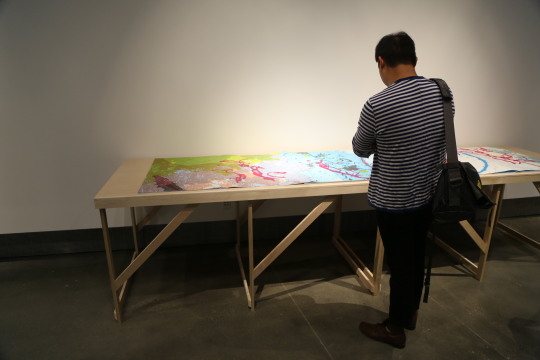

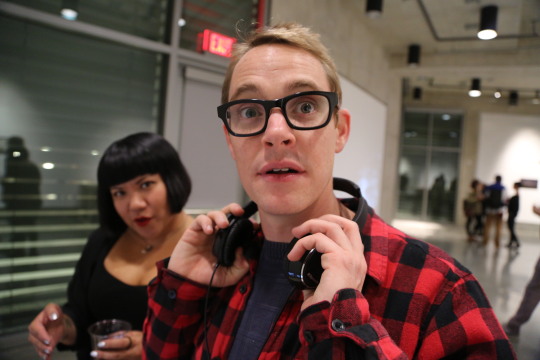
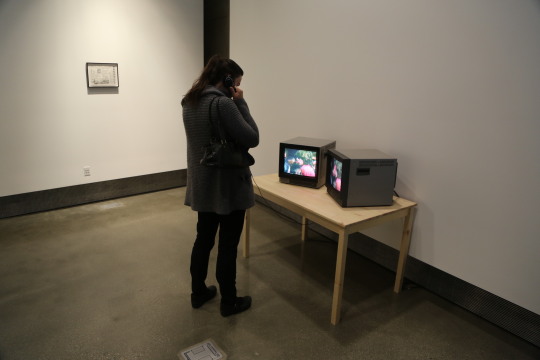
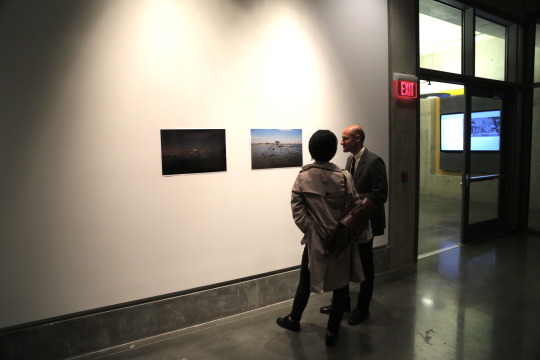
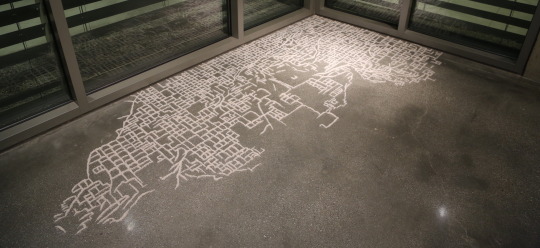




SUBTERRANEA Opening Reception
Photographs by Tanner Cook
1 note
·
View note
Text
sam durant

Sam Durant's series, Partially Buried/Altamont, includes drawings that explore concepts of transcendence via cultural icons from the seemingly disparate realms of visual art and popular music. In both a playful and poetic way, the series also critically responds to Rosalind Krauss’ diagram that makes the distinction between architecture and sculpture in her canonical essay, “Sculpture in the Expanded Field.” Durant works with a keen awareness of the problematic nature of how artist-legends who suffered tragic deaths become hauntingly omnipresent throughout time. This aspect is further exemplified by other works in the series, which includes portraits of paramount figures such as Robert Smithson and Kurt Cobain.
Soul Survivor (1998), the drawing selected for this exhibition, lifts its title from a song on the Rolling Stones’ groundbreaking record, Exile on Main Street. The album was put together in fits and starts between 1968 and 1972, mimicked here in Durant’s piecemeal and intentionally incomplete treatment of the drawing’s subject matter. Keith Richards’s broken smile appears in double, and film strip-like sketches of the Stones elsewhere in the drawing evoke or even directly point to Albert Maysles’ documentary, Gimme Shelter (1970). The film’s footage captured the event that changed the landscape of counter-culture forever—the violent death of audience member Meredith Hunter at the Altamont Speedway Free Festival in 1969.
“Soul Survivor” is itself a play on words. However, in the aftermath of the tragedy at Altamont, the title becomes a double entendre—not only is it a track from the album, but also a cryptic reminder of mass chaos and death crystallized into a single, sensationalized moment in time. The work is one of several examples of Durant’s juxtaposition of text and image that generates a matrix of fanaticism, violence and the catastrophic between disparate points in cultural memory.
What belies the Partially Buried/Altamont series and perhaps, more accurately, much of SUBTERRANEA as a whole, is the spectre of Robert Smithson. Durant’s imaginative re-titling of Maysles’s film in the 1999 work, Entropy in Reverse (Gimme Shelter Backwards), cites Smithson’s lifelong interest in the concepts of the entropic across a variety of cultural circumstances. Durant reveals social entropy in its most concentrated form.
#samdurant#altamont#1969#soulsurvivor#exileonmainstreet#rollingstones#mickjagger#albertmaysles#subterranea#ucsandiego#visualartsdepartment#entropy#entropyinreverse#robertsmithson
0 notes
Text
haris epaminonda

A hole is a mystery—a grave, an entrance, a failure, a void. The possibilities are limitless. In some cases, a hole’s author is its keeper, but a hole can also be a public entity—a tomb or landmark like the meandering depths of the pyramids or the vast pit left in the wake of 9/11. The largest holes in the world, such as the Grand Canyon, are among the most visible features of the planet from outer space.
It is quite odd, in fact, that a hole fulfills such a diversity of purposes and applies to a vast array of circumstances. At a small scale, a hole operates in the process of concealment—say, to bury documents, to hide something of value, or simply for an archive of the highly personal. In a different context, holes are a kind of smoke signal, if you will; they reside as marks or traces discernible from great atmospheric heights with the potential to reach distant entities of both known and unknown origins.
Schematic groupings of holes can suggest an altogether different scenario, however, as in Haris Epaminonda’s Untitled #60 (2009). Some kind of sign system is immediately suggested by the unusual symmetry of the excavations, but who is the receiver of such information if it is indeed a map of sorts? Compartmentalization is a possibility, but why then is one hole slightly bigger than the other? Perhaps, we can venture, the holes constitute a game of roughly human scale. Untitled #60, like other photographs of her Untitled polaroid series, says something of the artist’s interest in the arcane and often anonymous. Her frequent capture of the solitary figure, grouping or gaze makes one immediately question the circumstances of each image. Every photograph anchors a moment in time. However, it is challenging to imagine the figures and scenes of Epaminonda’s photographs ever having been in motion.
1 note
·
View note
Text
christopher kardambikis
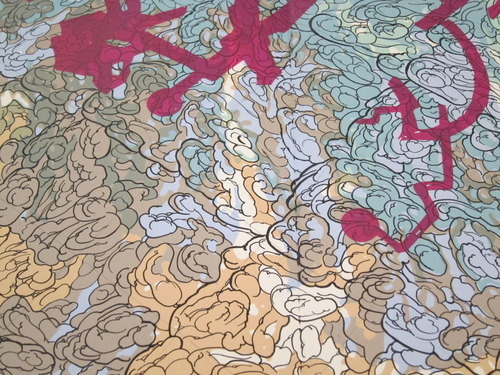
In 1665, Athanasius Kircher published Mundus Subterraneus, a two-volume illustrated treatise of both fact and speculation concerning the Earth’s interior. The work merged observations of volcanic activity and other geological and geographical data with an admixture of fantastical information about immense polar vortices, subterranean oceans, the living habits of underworld giants and an imagined system of fire pits.
Kircher was invested in the double meaning of the Latin word “mundus,” which denotes both “world” and “universe.” In the lineage of Kircher’s treatise, Christopher Kardambikis’ Mundus Subterraneus (2012) gives rise to an absurd, futuristic mythology of epic proportions. Kardambikis pulls from the history of book production itself as well as science fiction, myth and cosmology. The work also functions as an intimate atlas of artistic process, reflecting several key influences on Kardambikis’ practice. Reminiscent of Kircher’s play on the doubling of “mundus,” the visual information of Kardambikis’ book can be considered as both a series of two-page spreads or as a single 28-foot long image. In either case, one’s view is limited to a fragment or image of a larger schema. Like an atlas, an entire area is not viewed at once but rather is taken in as fractions of a whole. An atlas functions along both symbolic and temporal parameters—the symbolic in terms of its contents and the temporal with regard to the agglomeration of information page by page or one section at a time. In a similar manner, Kardambikis presents the viewer with sign systems of both the fantastic and the personal in an illustration that requires durational engagement. One must, quite literally, traverse the page.
#christopherkardambikis#subterranea#ucsandiego#visualartsdepartment#book#illustration#map#underworld#sciencefiction
3 notes
·
View notes
Text
gordon matta-clark

Gordon Matta-Clark’s 1977 film, Sous-Sols de Paris (Paris Underground), brings the viewer into a vertigo of failed vanishing points, descents and meanderings through Paris’ labyrinthine underground. His shots create a schizophrenic spectatorial experience; the work is at once a documentarian’s film and tactile/spatial exploration of surfaces and shapes. The viewer is led on a disorienting journey through a variety of unfrequented or altogether abandoned subterranean spaces: ossuaries, cellars, tunnels, basements and other areas in the Parisian opera district. Much of the film is composed of a progression of flashlit spaces narrated in French and dubbed with occasional music. Other shots are at odds with the narration—in one segment, the camera pans slowly over the time-worn surfaces of bones, while in another, a wavering, ethereal square of light (at the end of a tunnel) appears in total darkness.
In Matta-Clark’s underground spaces, faced with walls of skulls mere meters below the urban surfaces of Paris, one gains an unsettling sense of the proximity of the dead to the living--the viewer becomes, in a sense, the voyeur of ghosts. One may also imagine, perhaps, the limited cognition experienced by Plato’s prisoners in the allegory of the cave in The Republic. Yet it is not only the sequence of shots of subterranean Paris that evokes association with Plato’s cave. Sous-Sols also seems to mimic Socrates’ speculations about the escaped prisoner’s emergence from and subsequent return to the underground. Matta-Clark intersperses establishment shots of ruined façades at unorthodox intervals throughout the film. The dissonance between the flashlit illuminations of the underground and the glaring light of day disrupts the viewer’s sense of place, similar to the way that Socrates imagines the lone prisoner’s first encounter with the world. Regardless of Matta-Clark’s intent or the parallels we can draw, the film reminds us of the limitations of our perceptual experience.
PLATO--SHADOWS IN THE WALL OF A CAVE . . . DEPTH OF MEANING AND DEFINITIONS OF LAYERED REALITY. A WAY OF THOUGHT A SYSTEM OF PLAY.
- Gordon Matta-Clark, c. 1973
#gordonmattaclark#soussols#underground#subterranean#subterranea#ossuary#crypt#cave#ucsandiego#visualartsdepartment#1977
1 note
·
View note
Text
dominic paul miller


You may feel like you’re missing something. Or perhaps you’re trying to imagine yourself in the Salton Sea. Maybe you don’t know exactly what you’re looking at quite yet.
Cognitive dissonance is precisely what the three works by Dominic Paul Miller deliver. The photographs and sculpture (each existing as a form of material fragmentation—not unlike the geographical location of the Salton Sea itself) are all sites of the work. Miller is aware that places are imagined and created by uncontrollable forces, rendering them nearly impossible to grasp in their totality. The photographs, Salt Exclosure (day 2, noon sun) and Salt Exclosure (day 68, plant light) highlight the fact that we are only mere dots in motion on the topography of any site, present only in a fleeting, temporal moment. Salt Sculpture, Imperial Valley (cropped and tiled) is an ephemeral sculptural map made of salt from the site of inquiry, time- and site-specific in its material composition inside the gallery, susceptible to change by even a slight gust of air.
It is important to note that Miller’s investigation into the Salton Sea is not a lone endeavor. Initially, the artist worked with a team of student engineers to produce the galvanized steel and electrical pump assembly structure seen in the photographs in order to address the increased levels of salinity that threaten the Salton Sea environs. By working collaboratively and across fields, Miller explains that “the margin between social and ecological domains really became the focus; meanwhile, what is perceived as artificial or natural remains extremely ambiguous, even as we become increasingly aware of the complex systems within nature.”
The grouping of the photographs and salt map in SUBTERRANEA and a selection of Miller’s studies, sketches, journals and other works on paper (exhibited concurrently in the Discursive and Curatorial Productions Initiative space) underscore the displacement of his interrogation into the Salton Sea. Each piece, organic or manipulated, down to the finest grain of salt, is an autonomous object of its own. As viewers, we are granted access to this particular geographic landmark through the poetic subjectivity of the artist, documentation of his collaborative efforts and material manifestations of a visually complex, multivalent narrative. In this sense, we start to know more about the artist than we do of the site itself.
1 note
·
View note
Link
#geocritique#subterranea#ucsandiego#undergrounds#gordonmattaclark#samdurant#harisepaminonda#christopherkardambikis#dominicpaulmiller#press
0 notes
Text
FOR IMMEDIATE RELEASE: SUBTERRANEA

Architectural and natural environments’ root systems, foundations, and material infrastructures lay buried or concealed underground, largely unavailable to our immediate perceptual inquiries. Subterranean structures, associated with both literal and figurative conceptions of the underground, comprise the premise of the exhibition SUBTERRANEA. Notions of the subterranean are often inflected with the properties of the unknown, evoking the arcane and the afterlife. As an allegorical or psychological space, the subterranean is the site of Dostoevsky’s Notes from Underground and Dante’s Inferno; as a plural term, “subterranea,” or “undergrounds,” signifies political (the French Resistance), social (the Underground Railroad), and economic (the 17th century English “Diggers”) counter-cultural movements. SUBTERRANEA presents imaginative responses that bridge and transcend the literal, abstract, and metaphoric in the areas of video, photography, sculpture, and works on paper.
The UC San Diego Visual Arts Department and Discursive and Curatorial Productions Initiative are pleased to present SUBTERRANEA, a group exhibition curated by Melinda Guillen and Elizabeth D. Miller.
Image Caption: Sam Durant, Entropy in Reverse (Gimme Shelter Backwards), 1999, Video, Twin channel projection, 43:01 min, Courtesy the artist and Blum & Poe, Los Angeles
RELATED PROGRAMMING
October 10, 4 - 6pm, DCP Initiative (SME 406): Opening Reception for VOID/GRAVITY: DOMINIC PAUL MILLER, WORKS ON PAPER
October 16, 3 – 4pm, SME Visual Arts Gallery: SUBTERRANEA Exhibition Walk Through with curators Melinda Guillen and Elizabeth D. Miller
November 7, 8 – 10pm, SME Presentation Space: Screening of Gimme Shelter, 1970
November 21, 5 – 6pm, SME Presentation Space: Screenings of Nancy Holt’s Sun Tunnels, 1978 and Gordon Matta-Clark’s Underground Dailies, 1977-2005
#samdurant#gimmeshelter#subterranea#ucsandiego#ucsdvisarts#visualartsgallery#groupexhibition#patiofurniture
0 notes
Text
VOID/GRAVITY: DOMINIC PAUL MILLER, WORKS ON PAPER
Please join us earlier in the evening on October 10 in the Discursive and Curatorial Productions (DCP) Initiative space for the opening reception of VOID/GRAVITY: DOMINIC PAUL MILLER, WORKS ON PAPER and issue release of the second research notebook of Unweave, a collection of critical theory and scholarly essays organized and produced by the DCP Initiative and generously funded by the UC San Diego Visual Arts Department.
VOID/GRAVITY: DOMINIC PAUL MILLER, WORKS ON PAPER
Opening Reception & Unweave Issue no. 2 Release
Thursday, October 10, 2013 4 - 6pm
Discursive and Curatorial Productions Initiative
Structural & Materials Engineering Building Rm 406

Dominic Paul Miller, Rain Gatherer, 2008, Ink on mylar, 7 x 9," Courtesy the artist
#dominicpaulmiller#subterranea#ucsandiego#visualartsdepartment#discursiveandcuratorialproductions#dcp#worksonpaper#drawing#inkonmylar#graphite#unweave#patiofurniture
0 notes